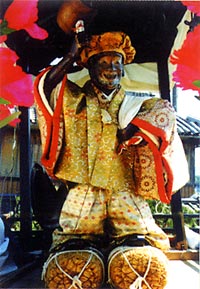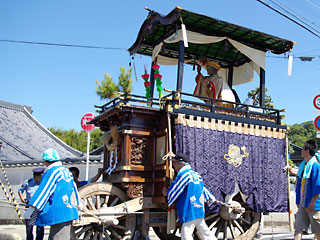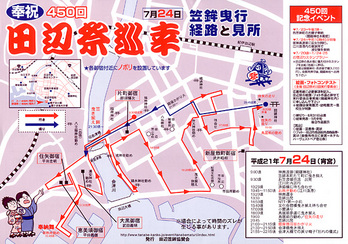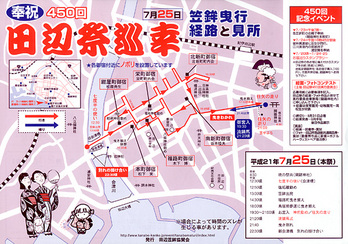
Every year on July 24th and 25th, the annual summer festival of Tokei-jinja Shrine is held. The year 2009 marked the 450th anniversary of the Tanabe Festival. In 1969 this festival, which is filled with much pomp and circumstance, was designated as an intangible folklore cultural asset of Wakayama prefecture.
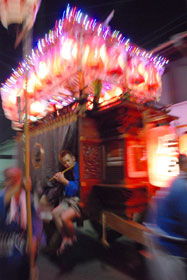
Festival Schedule
July 24
| 9:00 | Mikoshi Togyo from Tokei-jinja Shrine Kasahoko assemble in Hon-machi Procession in Egawa-cho |
| 10:25 | Mikoshi and Kasahoko gather at Egawa Port |
| 10:40~10:50 | Otabisho-zutome worshipping at Egawa Fishing Port |
| 13:20 | Mikoshi-kankou |
| 13:43 | Kasahoko procession |
| 15:40 | Kasahoko assemble at Kinan Cultural Hall |
| 16:10 | Kasahoko procession |
| 18:00 | Kasahoko assemble in front of Tokei-jinja Shrine |
| 19:00 | Kasahoko greeting ritual in front of the Torii gate & the ritual of Sumiya running |
| 20:45 | Kasahoko leave Tokei-jinja Shrine |
| 21:00~21:15 | Japanese traditional fire torches in Ginza shopping district |
| 21:30~21:50 | Kasahoko assemble on the Aizu-gawa Bridge |
| 21:55~22:15 | Modori Chigo, the ritual of separation |
July 25
| 4:30 | Akatsuki-no-saiten: the ritual of dawn |
| 12:30 | “Seven and half times welcome” on the Aizu-gawa Bridge |
| 12:50 | Shiogori purification ritual |
| 14:30 | Kasahoko assemble in Fukuro-machi |
| 17:30 | Kasahoko assemble in front of Torii gate |
| 19:30~21:00 | Entering the Tokei-jinja Shrine and greeting ritual in front of Kami & the ritual of Sumiya running |
| 21:10~21:20 | Yabusame, horseback archery demonstration |
| 21:40 | Farewell |
Tokei-jinja Shrine
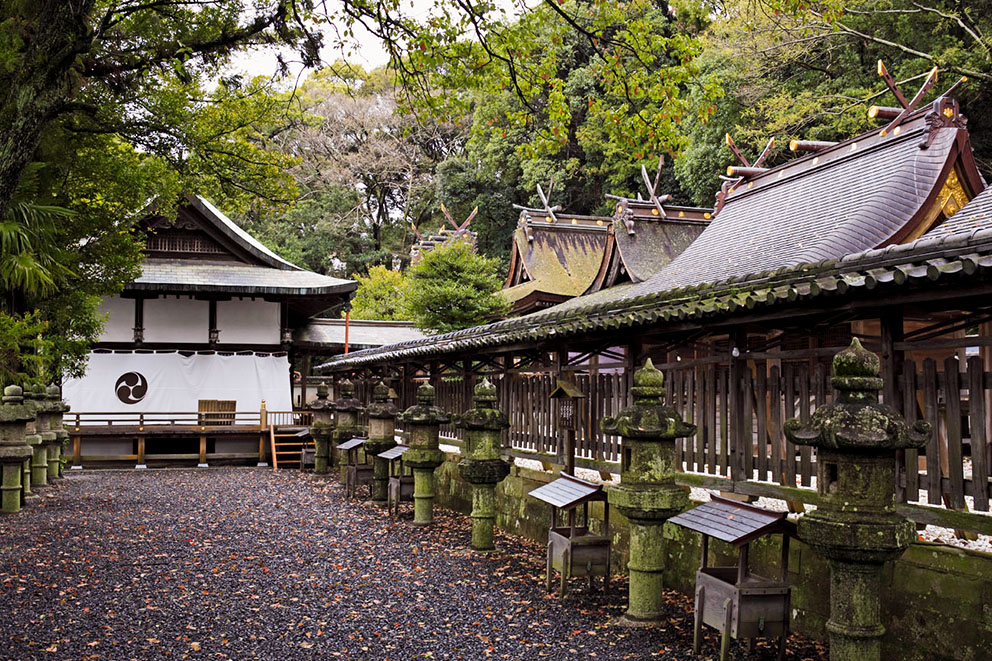
Tokei-jinja Shrine was established in 419 A.D and derives from Kumano Hongu Taisha. In the times of abdicated Emperor Shirakawa (1053-1129), the Kumano deities were enshrined in Tokei-jinja Shrine. Many imperial and aristocratic pilgrims paid homage here praying for safe passage into the realm of Kumano. Because the Kumano deities were manifested in Tokei-jinja Shrine, some pilgrims didn’t make the voyage into the heart of Kumano, but prayed here, subsequently worshipping the Kumano Sanzan from afar.
In the “Tales of Heike”the Kumano Betto (or steward of the Kumano shrines) turned to the gods to decide which side to join forces with during the historic sea battle of “Dan-no-ura” (1185)between the Heike and Genji clans by holding a divinatory cockfight here. By the order of the gods the Kumano Navy supported the Genji, turning the tide of the war, and destroying the Heike. During the shrine consolidations that took place in the Meiji era (1868-1912) this shrine was re-named “Tokei-jinja” or “cockfighting shrine” because of this event.
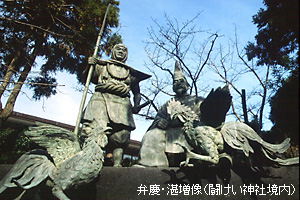
During the peak of the Kumano pilgrimage, Tanabe was an important junction and prospered as the entrance to the Kumano region. The city was a key location for both land and ocean transportation routes. People gathered in Tanabe before continuing onto the Kumano Sanzan or the Saigoku pilgrimage (33 Kannon pilgrimage of Western Japan).
History & Background
According to documentation from the 17th century, the Tanabe festival began around 1600. The festival’s present day form dates from the 1670s.
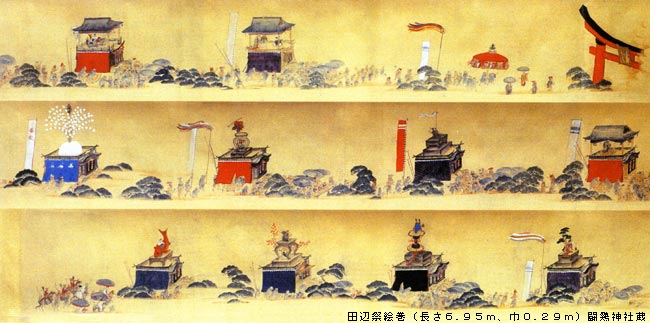
During the Tanabe Festival, you can see eight “Kasahoko” from the eight traditional districts related to the old castle and merchant towns of Tanabe. Locals call the Kasahokos “Okasa”. “Kasahoko” is a sort of “Dashi” which broadly means an attraction of an event. But specifically speaking, Dashi in a Japanese festival performs a sacred role. The Kanji characters for Dashi are 山車, which mean “mountain” and “wheel” or “vehicle”. Literally, Dashi are large elegant floats elaborately decorated and are related to the local history and Kami deities of the area. Dashi are pulled and pushed through the city by many men to pay homage at shrines and sacred sites. There is a great diversity of Dashi, with as many variations of Dashi as there are festivals in Japan.
In the Edo period (1603-1868) there were nine districts in Tanabe: Hon-machi, Fukuro-machi, Kata-machi, Konya-machi, Kaminaga-machi, Shimonaga-machi, Minami-shin-machi, Kita-shin-machi and Egawa. Each possesses one Kasahoko except Egawa, which has two. In 1870 Kaminaga-machi and Shimonaga-machi were amalgamated and became Sakae-Machi and in 1889 Konya-machi lost their Kasahoko in a severe flood. Konya-machi thus started using a “Kinugasa” umbrella instead of a Kasahoko from 1926.
Festival Procession
During the festival procession, the eight districts are divided into four teams or “gumi” which move together. Hon-machi is “Hon-machi Gumi.” Fukuro-machi, Konya-machi and Kata-machi are in the “Fukuro-machi Gumi.” Sakae-machi, Kita-shin-machi and Minami-shin-machi make up the “Sakae-machi Gumi.” And Egawa-cho is called the “Egawa Gumi.”
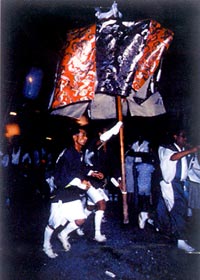
Egawa-cho possesses two Kasahokos and one “Sumiya”, an umbrella-like form of Kasahoko which performs the extremely important duty of purifying. In one ritual a designated festival participant runs as fast as possible carrying the sacred implement to expel evil spirits and cleanse the city. It also purifies the festival procession route by leading the other Kasahoko floats. The Sumiya can never retrace its path or turn right. The deity spirit of Sumiya is a nut pine. Every year the best branch of healthy Japanese red pine is chosen to be put on the top of Sumiya as a divine receptor for the spirits.
After the Sumiya, Egawa-cho’s two Kasahoko take the head of the procession followed by Hon-machi. The other teams follow, the order being changed every year.
Every Kasahoko is composed of one Oni (Japanese demon); “Sakibayashi” children who play traditional festival music; three men to play the Japanese style drums; three men to play the Japanese style flute; several facilitators; 4 to 15 guards; 9 to 20 men who move Kasahoko; and around 10 people to carry a large paper lantern. Only Hon-machi’s Kasahoko has two Tengu instead of Oni. Those who are in charge of instruments play festival music called “Ohayashi” inside of the Kasahoko, which sounds similar to ancient Japanese court music.
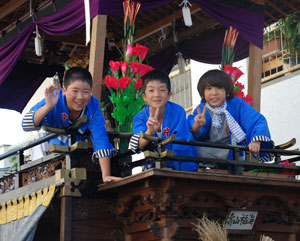
Yoinomiya: Festival Eve (July 24)
During the morning of Yoinomiya (festival eve), Kasahoko gather in Hon-machi to greet the Kami deities carried in the Mikoshi portable shrine and three young boys riding on sacred horses (the escorts of the kami).
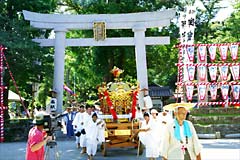
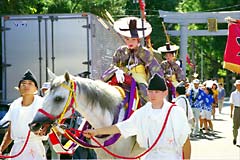
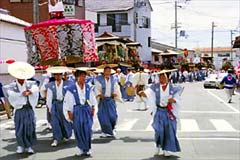
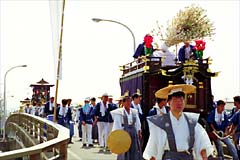
The Mikoshi-togyo ritual begins with the Kami departing Tokei-jinja Shrine in portable Mikoshi shrine followed by the Kasahokos while the Sumiya cleanses the way. The procession continues to Egawa port for a Shiogori saltwater purifying ritual. The procession returns to Tokei-jinja Shrine in the early evening, lining up just outside of the shrine complex.
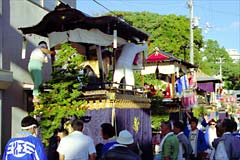
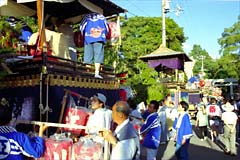
Around 19:00 the greeting ritual begins where each float offers respect to the Kami in front of the main Torii gateway, without entering the shrine grounds.
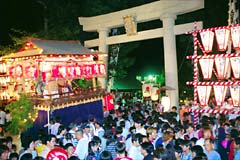
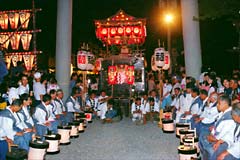
After the greeting rituals, the Kasahoko proceed to Aizu-bashi Bridge before they go back to their garage. This is the visual climax of the day as the procession in all of its glory is reflected off of the surface of the Aizu River.

Hon-matsuri: Festival Day (July 25)
At 4:30 the Akatsuki-no-Saiten ritual of dawn begins at Tokei-jinja Shrine. In the early morning silence, as if a flurry of festivity of the night before was like a dream, the ritual and “Urayasu-no-mai” (dance of Urayasu) is devoted to the Kami.
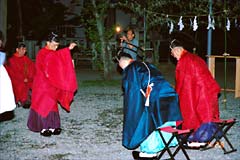
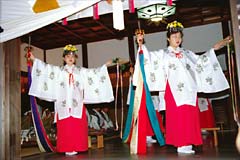
Kasahokos proceed around the city in the morning to arrive at Aizu-gawa Bridge by noon. Egawa team is on the Egawa, or west side of the river, and the other teams are on the east side of the river. From 12:30 the enigmatic “Nana-do-han no Tsukai” or “seven and half times welcome” ritual begins. Two men cross the bridge to request the presence of the Sumiya seven times. On the eighth attempt the Sumiya appears as they meet in the middle of the bridge, the group finally crossing to the east side.
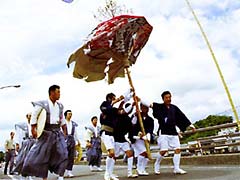
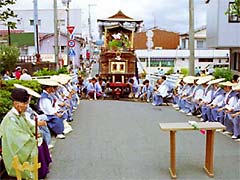
On the east side of the bridge, Shinto priest awaits the reunion of the Kasahoko and deliver “Shio-aka-ri” ritual to cleanse both the Sumiya and Kasahoko. After the Shio-aka-ri ritual, the procession through the city restarts.
The climax of the Tanabe festival takes place on the evening of the 25th. All of the Kasahoko gather in front of Torii gate of Tokei-jinja Shrine which initiates the “Omiya-iri” ritual. Omiya-iri (Entering the shrine) starts at 19:30 when the Sumiya enters to greet the Kami in then shrine pavilions and then runs to the mound next to Torii gate to undertake the final ritual of “Kasa-yabuchi”.
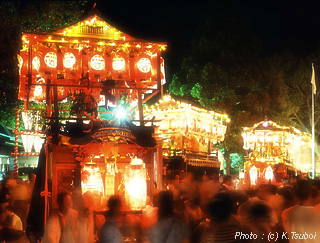
After this ritual, the Kasahoko finally start to enter the shrine grounds and each Kasahoko subsequently greets the Kami in front of the pavilions.
Around 21:10 the three Kami escort boys arrive at the shrine on horseback to perform the final ritual of the festival, “Yabusame”, arrow shooting. These boys demonstrate horseback archery in front of the Torii gateway, each shooting three arrows at a target.
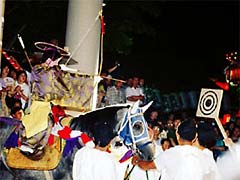
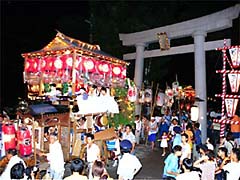
After the 9 shots, Horagai (conch shell horns) are blown to mark the end of the festival. The Kasahoko then prepare for their departure from the shrine. With the second horn, the Kasahoko leave the sacred precincts and return to their respective neighborhoods.
Egawa Kasahoko goes back to Egawa district crossing the Aizu-bashi Bridge. Kata-machi, which is next to Egawa district, sees the Egawa Kasahoko off from the other side of the bridge, the closeing highlight of the elaborate Tanabe Festival.
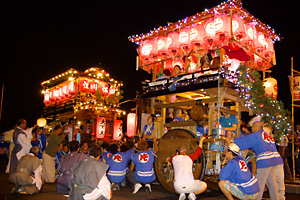
Kasahoko Floats
Hon-machi
The main objects of the Hon-machi Kasahoko are dolls representing an elderly couple from the ancient Noh drama called “Takasago”, written by the famous dramatist Zeami (1363-1443). In the tale of Takasago, a Shinto priest from Aso meets an old couple at Takasago Bay on his way to Kyoto. Afterward, the priest discovers that they were actually the spirits of the Aioi pine tree, which miraculously has two different kinds of trees growing from the same root. Subsequently, the old couple became associated with happiness and long life together.
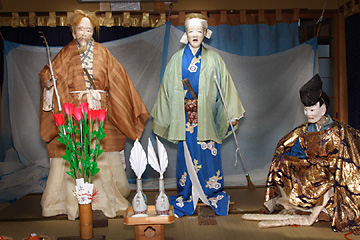
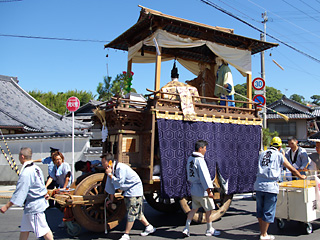
Konya-machi
Konya-machi’s Kasahoko is a “Kinugasa,” a giant umbrella made with gold fabric curtains, trimmed with embroidery featuring the symbol of Kumano, the sacred Yata-garasu (three-legged crow). For the festival, fresh pine tree branches decorate the top of it. Konya-machi used to have an Okasa float like other districts, but it was destroyed by a large flood in 1889. Before the flood, the Kinugasa of Konya-machi was decorated with dolls of famous historical people such as Fuhito Fujiwara (659-720), Kiyomori Taira (1118-1181) and Kukai (774-835).
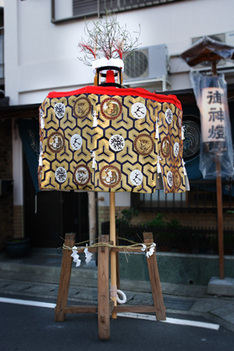
Sakae-machi
The main icon of Sakae-machi’s Kasahoko is “Shojo,” the legendary divine being from the ocean who loves to drink Sake (Japanese rice wine). The legend of Shojo takes place in China regarding the relationship between an honest man called Kofu and Shojo. One night Kofu had a revelation to start selling sake at a market to become a rich man. Later, after he became a successful man, he noticed one of his customers kept drinking and seemed not to be drunk at all. Kofu asked who he was and the man answered that he was Shojo from the ocean.
Kofu then tried to discover if what he said was true. He brought sake to the beach and waited for Shojo to appear. Miraculously Shojo showed up, drank the sake and started to dance. Shojo praised Kofu’s honest heart and gave him a sake vase that never dries up.
Sakae-machi has two other objects for Kasahoko, which are Jingu Empress (170-269) and the mysteriously long-living Takenouchi-no-sukune (84-390), one of her main servants.
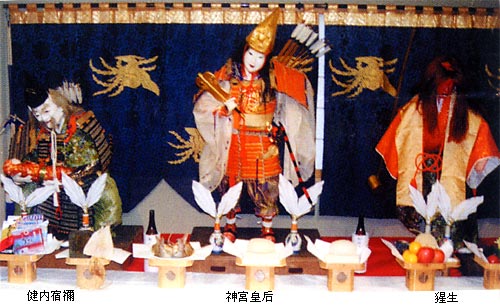
Minami-shin-machi
Minami-shin-machi Kasahoko has four objects of worship. The doll representing Yoshisada Nitta (1301-1338) is the main icon. Yoshisada Nitta was a prestigious samurai who fought to bring down the Kamakura feudal government. He prayed the Ryujin dragon god of the ocean through his sword in the sea. The waters faded away and the ocean quickly became a tidal wetland, making it possible for his army to enter Kamakura and win a decisive battle.
The other three icons are: “Susano-no-mikoto” (Kami in Japanese mythology), “Ushiwaka-maru” (Yoshitsune Minamoto’s in his youthful years) and “Shiokumi” (from famous Noh story Matsukaze).
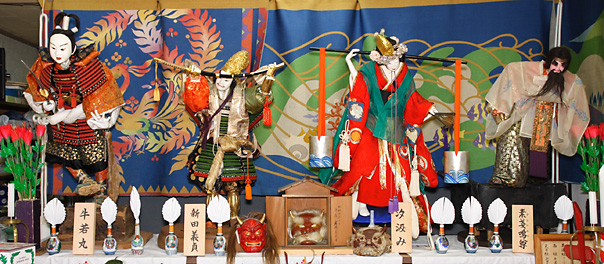
Fukuro-machi
The icon of Fukuro-machi is Yamato Takeru no Mikoto who was a legendary hero both in history and mythology. After he died he turned into a white swan and flew away.
Fukuro-machi based the doll on Yamato Takeru no Mikoto from a painting in Tatebu Taisha in Shiga prefecture.
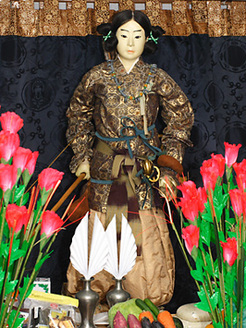
Kata-machi
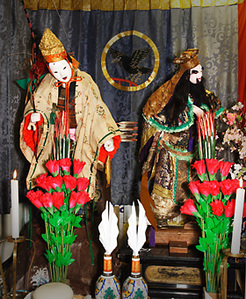
Kata-machi has two icons, one is “Kanu: Guan Yu (?-219)” from Sangokushi (Three Kingdom Saga) and the other is “Empress Jingu.”
“Kanu” was a military commander of the Go-Kan state and a sworn brother of Ryubi Gentoku (161-233). He performed meritorious service in the war of red cliff. Gifted with a strong sense of duty, he became popular and loved by Chinese people. Admiration for him was manifested in the fact that he became the 47th divine being in China. He became known as a god of business and war for always being trustworthy and loyal. Kanu is displayed in the Kasahoko on the 24th.
Another icon Empress Jingu (170-269) is displayed in the Kasahoko on the 25th. Empress Jingu; her other name is Okinagatarasime-no-mikoto was a wife of the 14th Emperor Chuai (?-200). After Emperor Chuai suddenly passed away she took control of political administration as a regent from 201 to 269. In the Kojiki (Records of Ancient Matters), there is an anecdote that describes her journey to the Korean peninsula, instead of her deceased husband, to continue the war when she was pregnant, giving birth when she came back home.
Kitashin-machi
Since 1694 the successive Kitashin-machi’s Kasahoko icons were from Tadahira Fujiwara (880-949), Souu (dates of birth and death are unknown) from Sangokushi,Chinese politician Hanrei (dates of birth and death are unknown) and a fighting scene of Yorimasa Minamoto (1104-1180) with a legendary Japanese demon Mue which has a monkey’s face, raccoon’s body, tiger’s limbs and the tail of a snake. The scene also depicts an ascetic monk training in the Nachi falls.
From 1801, the icon has been a “Mochi-bana”, a bundle of long wooden sticks with small mocha (rice cakes) attached at certain intervals. It is an ornament to pray for an abundant harvest.
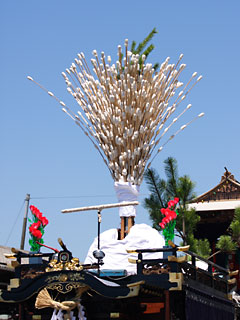
Egawa-cho
Egawa possesses two kasahokos and their Kasahoko icons have been Yebisuand Daikoku since Edo period. Yebisu is Kami of fishing, agriculture and business. It is said that he has a majestic Oni-demon face, but becomes softer and nicer when he puts on his costume. He is one of the members of Japanese seven lucky Kami “Shichifuku-jin.”
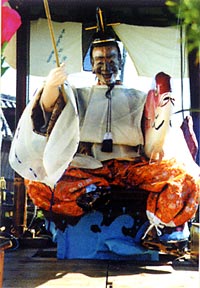
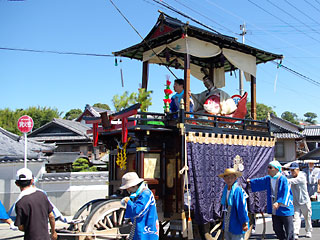
Daikoku is the Kami of abundant crops and also one of the members of Japanese seven lucky kami “Shichifuku-jin.” The Daikoku doll can only be touched and moved by a limited number of specified handlers.
